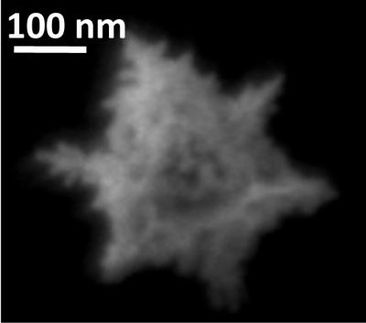Precious metal gets picky
Gold nanoparticles adhere to only certain faces of crystals of the amino acid cystine
gold nanoparticles stand out through their unique optical, electronic, and catalytic properties and are the ideal "building blocks" for nanostructures. Composite materials with a one or two-dimensional arrangement of the gold nanoparticles are especially interesting for the construction of components on the nanoscale. Japanese scientists have now shown that crystals of organic compounds are the ideal partner for such gold composite materials. Gold nanoparticles do not colonize all the surfaces of the organic crystal evenly, they are choosy, and occupy only certain faces.
The researchers working with Seiji Shinkai and Kazuki Sada employ millimeter-sized single crystals of the amino acid L-cystine. A single crystal is composed of a single, uniform crystal lattice. Cystine crystallizes in the form of hexagonal prisms. Such a crystal has two parallel hexagonal surfaces the edges of which are linked together by six rectangular faces. If the transparent crystal is immersed for two hours in a solution of gold nanoparticles it becomes purple. Under the microscope it can be seen that only the two hexagonal faces are purple. The sides, that is, the rectangular faces remain colorless. The purple coloration arises from deposited gold nanoparticles. Clearly the tiny gold particles are choosy and populate exclusively the hexagonal faces of the prism.
Why? The cystine molecules are arranged in layers in the crystal, these layers are parallel to the hexagonal faces. The layers are held together by a two-dimensional network of hydrogen bonds that run between the amino and the acid groups of the amino acid. These polar groups lie on the surface of the two hexagonal faces and attract the gold particles by electrostatic interactions. The rectangular faces, however, are made up of alternating layers of polar and nonpolar groups. The density of attractive polar groups here is too low to draw the gold particles onto these faces.
The face-selective coverage also works with microscale crystals. The gold coating could be used, for example, to selectively bind other materials. Through the attractive and repulsive forces between coated and uncoated faces of the crystals it should be possible to make the crystals stack in a direction-dependent manner and so form defined aggregate structures in a targeted fashion.
Topics
Organizations
Other news from the department science

Get the analytics and lab tech industry in your inbox
By submitting this form you agree that LUMITOS AG will send you the newsletter(s) selected above by email. Your data will not be passed on to third parties. Your data will be stored and processed in accordance with our data protection regulations. LUMITOS may contact you by email for the purpose of advertising or market and opinion surveys. You can revoke your consent at any time without giving reasons to LUMITOS AG, Ernst-Augustin-Str. 2, 12489 Berlin, Germany or by e-mail at revoke@lumitos.com with effect for the future. In addition, each email contains a link to unsubscribe from the corresponding newsletter.

























































